Nursing research—a win for nurses and patients.
Takeaways:
- Mobile handheld devices are being used at more often in healthcare settings.
- These devices have the potential to be infection carriers and cause healthcare-associated infections.
- The disinfection technique of 70% isopropyl alcohol and 15 seconds of friction can reduce the bioburden on devices, reducing the chances of spreading infection.
More and more healthcare professionals use mobile handheld devices (MHDs)— tablets and smartphones—to facilitate care documentation and as resource tools. In fact, 50% to 60% say they use MHDs during patient care. Unfortunately, these devices have the potential to carry infectious organisms, which can lead to spreading healthcare-associated infections (HAIs). In the United States, 5% to 10% of patients are affected by HAIs each year, resulting in 99,000 deaths and an estimated $20 billion in healthcare costs.
To address this concern, the Nursing Research Council (NRC) at our 451-bed American Nurses Credentialing Center Magnet®-recognized, full-service hospital developed and conducted a research study to investigate the infection potential of MHDs and possible cleaning methods.
The research
The NRC, whose mission is to foster a culture of nursing research and promote application of evidence-based practice that facilitates optimal outcomes in healthcare, was empowered by the organization to conduct a professional research study. NRC members, including bedside nurses from several inpatient units and clinical nurse specialists, began with a brain-storming session and literature review to evaluate and investigate the potential for bacterial contamination of medical equipment (keyboards, stethoscopes, sharps containers, MHDs) used during patient care.
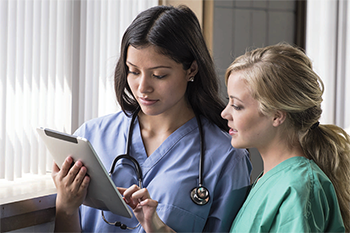

Although the literature supported the potential for MHDs to harbor bacteria, the NRC found little research about disinfection recommendations for MHDs in hospitals. The council members decided to research best practice guidelines for disinfecting MHDs. They found several general cleaning guidelines from product manufacturers, the Centers for Disease Control and Prevention (CDC), and previously conducted studies. Apple, for example, suggests using a soft, slightly damp, lint-free cloth for their mobile devices, including phones and tablets. However, the manufacturer warns that abrasive cloths might damage screens. The CDC recommends cleaning regimens that are effective, fast- acting, easy to follow, and economic. After completing the literature view, the council chose 70% isopropyl alcohol wipes (which are easily accessible to the staff and cost efficient) and 15 seconds of friction as the disinfection technique for their study. The wipes were supplied by the organization in support of shared governance activities.
The study
The council conducted its study in January 2017. They received institutional review board (IRB) approval through an expedited review process before collecting data. The purpose of the study was to evaluate potential bioburden on MHDs and to develop a fast, effective, and cost-efficient cleaning method. (See Bioburden defined.)
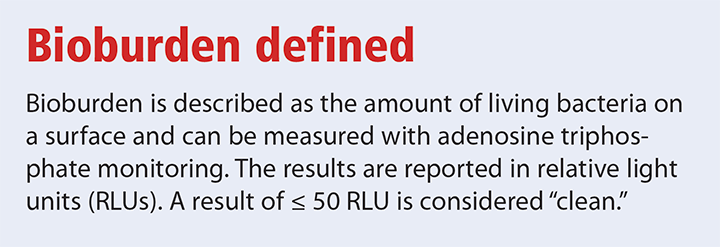

Fifty night-shift staff members were recruited to participate in the study. At the end of their shift, they signed written consent forms to have their MHDs swabbed using Hygiena UltraSnap Swabs and SystemSURE Plus adenosine triphosphate(ATP) monitoring. (See The process.)
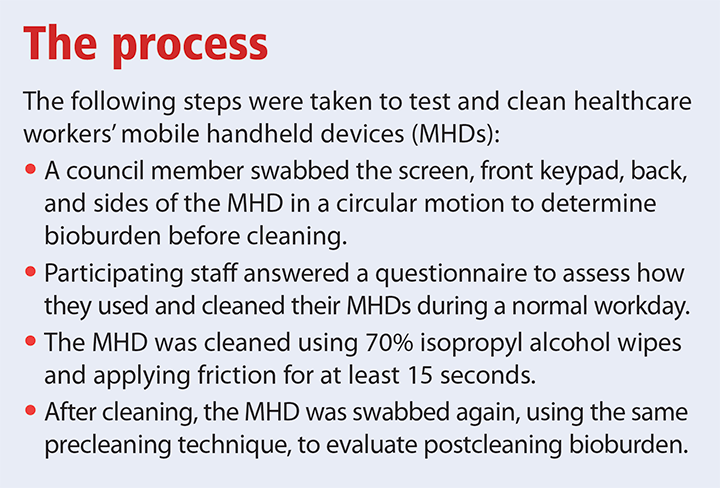

The results
The study concluded that the mean preclean MHD bioburden was 106.8 relative light units (RLUs), indicating bacterial contamination. The mean post-clean bioburden was 49.98 RLUs, within the “clean” range. The results indicate that this regimen (70% isopropyl alcohol and 15 seconds of friction) effectively cleans MHDs and decreases the risk of spreading harmful bacteria to patients in the healthcare setting. Before the study began, participants were asked what cleaning method they used for their MHDs. About 64% said they use isopropyl alcohol, and 50% said they had cleaned their phone within the last 12 hours. Each participant received an email with personal results, including pre- and post-bioburden, for theirMHDs.
The dissemination
The NRC shared the study results throughout the organization. The council circulated a poster of the findings through all the nursing units and presented the overall results and a cleaning demonstration during a shared governance professional practice day. In addition, two NRC members gave a poster presentation at a regional nursing conference.
Empowerment through research
When a healthcare organization encouragesnurses to conduct and disseminate research, it empowers them to participate in advancing the nursing profession. The NRC at our organization continuously looks for research opportunities that will improve care, increase efficiency, and promote nursing.
The authors work at Mary Washington Health care in Fredericksburg, Virginia. Brandy Wentz is a nurse in the medical intensive care unit, and Mary Jane Bowles is the critical care clinical nurse specialist.
Selected references
Centers for Disease Control and Prevention. Healthcare-associated infections: Preventing healthcare-associated infections. Updated November 16, 2015.
Centers for Disease Control and Prevention. Healthcare-associated infections. Updated April 20, 2018.
Heyba M, Ismaiel M, Alotaibi A, et al. Microbiological contamination of mobile phones of clinicians in intensive care units and neonatal care units in public hospitals in Kuwait. BMC Infect Dis. 2015;15:434.
Manning ML, Davis J, Sparnon E, Ballard RM. iPads, droids, and bugs: Infection prevention for mobile handheld devices at the point of care. Am J Infect Control. 2013;41(11):1073-6.
Pal S, Juyal D, Adekhandi S, et al. Mobile phones: Reservoirs for the transmission of nosocomial pathogens. Adv Biomed Res. 2015;4:144.

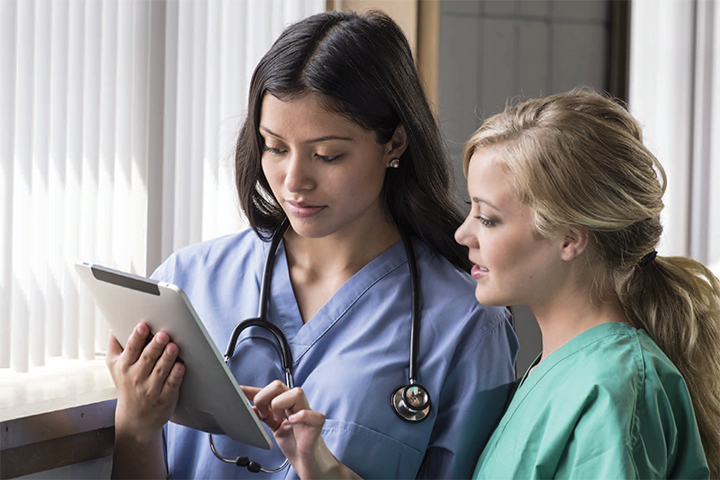




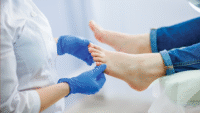

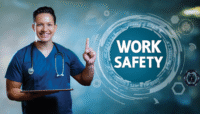










1 Comment.
Good share Brandy, most of the healthcare industry manage and control mobile devices and tablets from their laptop or desktop using a kiosk lockdown solution like MobiLock Pro, which allows them to select apps, websites and content that can be accessed by an end-user.